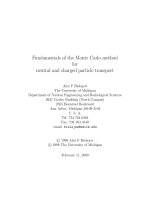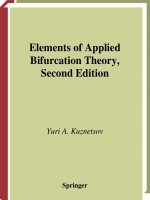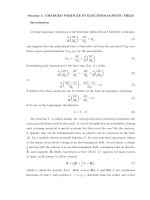- Trang chủ >>
- Khoa Học Tự Nhiên >>
- Vật lý
Helmut liebl applied charged particle optics springer (2008)
Bạn đang xem bản rút gọn của tài liệu. Xem và tải ngay bản đầy đủ của tài liệu tại đây (3.41 MB, 136 trang )
Applied Charged Particle Optics
www.pdfgrip.com
Helmut Liebl
Applied Charged Particle Optics
With 124 Figures
123
www.pdfgrip.com
Dr. Helmut Liebl
Hartstr. 17
85386 Eching
Germany
Library of Congress Control Number: 2007932728
ISBN 978-3-540-71924-3 Springer Berlin Heidelberg New York
This work is subject to copyright. All rights are reserved, whether the whole or part of the material
is concerned, specifically the rights of translation, reprinting, reuse of illustrations, recitation, broadcasting, reproduction on microfilm or in any other way, and storage in data banks. Duplication of
this publication or parts thereof is permitted only under the provisions of the German Copyright Law
of September 9, 1965, in its current version, and permission for use must always be obtained from
Springer. Violations are liable to prosecution under the German Copyright Law.
Springer is a part of Springer Science+Business Media.
springer.com
© Springer-Verlag Berlin Heidelberg 2008
The use of general descriptive names, registered names, trademarks, etc. in this publication does not
imply, even in the absence of a specific statement, that such names are exempt from the relevant protective laws and regulations and therefore free for general use.
Typesetting: Data prepared by the Author and by SPI Kolam
Cover: eStudio Calamar Steinen
Printed on acid-free paper
SPIN 11903109
57/3180/SPI
543210
www.pdfgrip.com
To my dear wife Elfie,
and our children
Bernhard, Wolfgang, Regina, Christina, Martin,
and our grandchildren.
www.pdfgrip.com
Preface
This booklet is essentially an extended English version of a course I
taught at the Max Planck Institute for Plasma Physics in Garching/
Munich for physicists and graduate students working at the Institute
and for the nearby Physics Department of the Technical University.
It covers mostly applications of particle optics which I have designed,
built and worked with myself during my career, such as mass spectrometry, focusing of ion beams, emission microscopy, ion and electron beam
systems, in an energy range of less than 20 keV.
It is intended to help physicists who have to design their own apparatus or to help them to better understand instruments they have to
work with.
Some of the subjects described date back quite some time, the oldest
references as far back as the thirties in the last century. And I am
old enough to have met some of those authors personally. But the
booklet also contains some material from my own file which has not
been published previously.
I should like to thank Dr. Dietmar Wagner for his invaluable help
with the manuscript.
Eching, August 2007
Helmut Liebl
www.pdfgrip.com
Contents
1
Lenses: Basic Optics . . . . . . . . . . . . . . . . . . . . . . . . . . . . . . . . .
1.1 Simple Transfer Matrices . . . . . . . . . . . . . . . . . . . . . . . . . . . .
1.2 Passage of Charged Particles Through
a Uniform Electrostatic Field . . . . . . . . . . . . . . . . . . . . . . . .
1.3 Transfer Matrix of the Uniform Field . . . . . . . . . . . . . . . . .
1.4 Acceleration of Charged Particles Emitted
from a Planar Surface . . . . . . . . . . . . . . . . . . . . . . . . . . . . . .
1.5 Transfer Matrix of Electrostatic Field
Between Spherical Concentric Equipotential Surfaces . . .
1.6 Acceleration of Charged Particles Emitted
from a Spherical Surface . . . . . . . . . . . . . . . . . . . . . . . . . . . .
1.7 Passage of Charged Particles Through an Electrode
with Round Aperture . . . . . . . . . . . . . . . . . . . . . . . . . . . . . . .
1.8 General Aperture . . . . . . . . . . . . . . . . . . . . . . . . . . . . . . . . . .
1.9 Passage of Charged Particles Through an Electrode
with Slotted Aperture . . . . . . . . . . . . . . . . . . . . . . . . . . . . . .
1.10 Emission Lenses . . . . . . . . . . . . . . . . . . . . . . . . . . . . . . . . . . . .
1.11 Immersion Lenses . . . . . . . . . . . . . . . . . . . . . . . . . . . . . . . . . .
1.12 Einzel Lenses . . . . . . . . . . . . . . . . . . . . . . . . . . . . . . . . . . . . . .
1
4
7
13
14
16
16
18
21
24
26
34
39
2
Electrostatic Deflection . . . . . . . . . . . . . . . . . . . . . . . . . . . . . .
2.1 Parallel Plate Condenser . . . . . . . . . . . . . . . . . . . . . . . . . . . .
2.2 Cylindrical Condenser . . . . . . . . . . . . . . . . . . . . . . . . . . . . . .
2.3 Spherical Condenser . . . . . . . . . . . . . . . . . . . . . . . . . . . . . . . .
2.4 Toroidal Condenser . . . . . . . . . . . . . . . . . . . . . . . . . . . . . . . . .
3
Magnetic Deflection . . . . . . . . . . . . . . . . . . . . . . . . . . . . . . . . . . 67
3.1 Small Deflection Angles . . . . . . . . . . . . . . . . . . . . . . . . . . . . . 67
www.pdfgrip.com
45
45
47
55
59
X
Contents
3.2 Magnetic Sector Fields . . . . . . . . . . . . . . . . . . . . . . . . . . . . . . 69
3.3 Axial Focusing with Uniform Magnetic Sector Field . . . . 74
3.4 Non-Uniform Magnetic Sector Fields . . . . . . . . . . . . . . . . . . 78
4
Image Aberrations . . . . . . . . . . . . . . . . . . . . . . . . . . . . . . . . . . . 89
4.1 Lenses . . . . . . . . . . . . . . . . . . . . . . . . . . . . . . . . . . . . . . . . . . . . 89
4.2 General Toroidal Condenser . . . . . . . . . . . . . . . . . . . . . . . . . 91
4.3 Spherical Condenser . . . . . . . . . . . . . . . . . . . . . . . . . . . . . . . . 95
4.4 Cylindrical Condenser . . . . . . . . . . . . . . . . . . . . . . . . . . . . . . 96
4.5 Uniform Magnetic Sector Fields . . . . . . . . . . . . . . . . . . . . . . 98
4.6 Non-Uniform Magnetic Sector Fields . . . . . . . . . . . . . . . . . . 101
5
Fringe Field Confinement . . . . . . . . . . . . . . . . . . . . . . . . . . . . 105
A Applications . . . . . . . . . . . . . . . . . . . . . . . . . . . . . . . . . . . . . . . . . 109
A.1 Emission Lens Combined
with Optical Mirror Objective Lens . . . . . . . . . . . . . . . . . . . 109
A.2 Combined Objective and Emission Lens . . . . . . . . . . . . . . . 110
A.3 Dynamic Emittance Matching . . . . . . . . . . . . . . . . . . . . . . . 117
A.4 Energy Analyzer for Parallel Beam
with Coinciding Entrance and Exit Axes . . . . . . . . . . . . . . 117
A.5 Elimination of Transverse Image Aberrations
of Sector Fields . . . . . . . . . . . . . . . . . . . . . . . . . . . . . . . . . . . . 123
A.6 Energy-Focusing Mass Spectrometers . . . . . . . . . . . . . . . . . 124
References . . . . . . . . . . . . . . . . . . . . . . . . . . . . . . . . . . . . . . . . . . . . . . . 127
Index . . . . . . . . . . . . . . . . . . . . . . . . . . . . . . . . . . . . . . . . . . . . . . . . . . . . 129
www.pdfgrip.com
1
Lenses: Basic Optics
Summary. Basic optical formulae are derived, the transfer matrix method is explained, the lens action of apertures is shown, and emission, immersion and einzel
lenses are treated.
A lens is characterized by the property that it imparts to a ray (particle
trajectory) passing through it a deflection (∆r ) which is proportional
to the distance r1 from the axis, at which the ray passes, but which
is independent of the original slope r1 . For thin lenses this deflection
may be assumed to be a sharp kink, occurring at the single principal
plane P . If the entrance side – left of P – is designated by the index 1,
and the exit side – right of P – by the index 2, one can write that the
exit distance r2 equals the entrance distance r1 (Fig. 1.1):
(1.1)
r1 = r2 ,
and the exit slope r2 equals the entrance slope r1 plus the (negative)
change of slope ∆r :
r2 = r1 + ∆r .
(1.2)
As stated above, −∆r = cr1 , where c is the proportionality constant.
It can be derived from the special case that the exit ray is parallel to
the axis:
r1 = −∆r = cr1 ,
(1.3)
r2 = 0,
1
−∆r
= .
(1.4)
c=
r1
f1
In this case (Fig. 1.2) the entrance ray crosses the axis at the distance
f1 from P ; f1 is the entrance focal length of the lens, F1 the entrance
focal plane. Equation (1.2) can now be written as
r1
(1.5)
r2 = r1 − .
f1
www.pdfgrip.com
2
1 Lenses: Basic Optics
Fig. 1.1. Principle of a lens: A trajectory crossing the lens at distance r1 from the
z-axis is deflected by an angle ∆r which is proportional to r1
Fig. 1.2. Trajectories starting from the axis point F – the focal point – leave the
lens parallel to the z-axis. The distance of the focal plane F1 to the lens plane P is
the focal length f1
Equations (1.1) and (1.5) can be written in matrix form
r
r
=
2
1 0
− f11 1
r
r
= ML
1
ML is called the transfer matrix of the lens.
www.pdfgrip.com
r
r
,
1
(1.6)
1 Lenses: Basic Optics
3
The transfer matrix is
ML =
a11 a12
a21 a22
with the coefficients
a11
a12
a21
a22
= 1,
= 0,
= −1/f1 ,
= 1.
In explicit form one has
r2 = a11 r1 + a12 r1 ,
r2 = a21 r1 + a22 r1 .
This, with the above coefficients for a lens, yields (1.1) and (1.5).
Another way of describing the action of a lens is in the form of the
exit equation of the ray in the z–r coordinate system (Fig. 1.3):
r = ar1 + zr2 = ar1 + z r1 −
r1
f1
,
where a is the distance of the object point A from P . With r1 = ar1
we have
a
r = a+z 1−
r1 .
(1.7)
f1
Fig. 1.3. The object point A is imaged to a virtual image point B if a < f1
www.pdfgrip.com
4
1 Lenses: Basic Optics
Fig. 1.4. Imaging of an extended object through a lens to a real image
The distance of the image point B – the point where the exit ray crosses
the axis – from P, i.e. the image distance b, is obtained from (1.7) with
r = 0:
a
= 0.
a+b 1−
f1
By dividing it by ab, this yields the familiar lens equation
1
1 1
+ = .
a b
f1
(1.8)
For a < f1 , as in Fig. 1.3, the image distance b is negative, i.e. the
image is virtual.
For lenses, where the particle energy is the same on both the entrance and exit side, the focal lengths are also the same on both sides:
f2 = f1 = f.
(1.9)
For the imaging of an extended object (Fig. 1.4) the same rules apply
as in light optics:
b
s2
= ,
s1
a
1
r
.
angular magnification: 2 =
r1
M
lateral magnification: M =
(1.10)
(1.11)
Electrostatic lenses are generally thick lenses which have two principal planes P1 and P2 , and these are usually interchanged as shown in
Fig. 1.5.
1.1 Simple Transfer Matrices
The transfer matrix of a lens has been introduced above. Transfer matrices become very useful when composite optical systems consisting
www.pdfgrip.com
1.1 Simple Transfer Matrices
5
Fig. 1.5. Schematic of electrostatic lens with interchanged principal planes P1
and P2
Fig. 1.6. Drift space without deflection
of several elements in tandem are to be treated. Frequently, just one
property of the composite system is of interest, e.g. the magnification,
and therefore only one of the matrix coefficients needs to be calculated,
which can often be done very quickly with the aid of a hand calculator.
The simplest transfer matrix is that of a drift space (Fig. 1.6).
From the figure one can see immediately that
r2 = r1 + L r1 ,
r2 = r1 ,
(1.12)
(1.13)
or in transfer matrix form
r
r
=
2
1L
01
r
r
= MD
1
r
r
.
(1.14)
1
When two optical elements are combined in tandem, their respective
transfer matrices have to be multiplied. For the combination of a lens
www.pdfgrip.com
6
1 Lenses: Basic Optics
Fig. 1.7. Combination of einzel lens with drift space
and a drift space (Fig. 1.7) one has therefore to multiply the transfer
matrices of the lens and the drift space:
r
r
=
3
r
r
b11 b12
b21 b22
=
3
a11 a12
a21 a22
drift space
lens
2
drift space
r
r
b11 b12
b21 b22
=
c11 c12
c21 c22
r
r
.
1
The coefficients cik are found according to the scheme
2
cik =
bis ask ,
i, k = 1, 2,
s=1
or explicitely
c11 = b11 a11 + b12 a21 ,
c12 = b11 a12 + b12 a22 ,
c21 = b21 a11 + b22 a21 ,
c22 = b21 a12 + b22 a22 .
In our example, we have with (1.14),
b11 = 1,
b12 = L,
b21 = 0,
b22 = 1.
www.pdfgrip.com
r
r
,
1
(1.15)
1.2 Passage of Charged Particles Through a Uniform Electrostatic Field
7
With these and the coefficients of the lens transfer matrix, one then
obtains
L
c11 = 1 − , c12 = L,
f
1
c21 = − , c22 = 1.
f
Explicitly, this reads
r2 = r1 + L r1 −
r2 = r1 −
r1
f
,
r1
.
f
When the sequence of the two elements is reversed, i.e. drift space
followed by lens, the aik s and bik s are interchanged. This yields
c∗11
c∗12
c∗21
c∗22
c∗11
c∗21
= a11 b11 + a12 b21 ,
= a11 b12 + a12 b22 ,
= a21 b11 + a22 b21 ,
= a21 b12 + a22 b22 ,
= 1,
c∗12 = L,
1
L
c∗22 = 1 − .
=− ,
f
f
1.2 Passage of Charged Particles Through
a Uniform Electrostatic Field
Figure 1.8 shows the important case where a charged particle is accelerated through a uniform field between the equipotential planes denoted
P1 and P2 . The spaces to the left of P1 and right of P2 are field free and
have the potentials V1 and V2 . The potentials are counted from where
the charged particles have zero energy so that their kinetic energy in
flight direction at any point in space with the potential Vi is eVi .
In this simple case the differential equations of motion can be
straightforwardly integrated and yield the motion of the particle in
the zr-coordinate system as a function of time t:
m ră = 0,
mă
z = eE,
z1 = v1 cos 1 ,
z1 = r1 = 0,
r˙1 = v1 sin α1 , v1 =
www.pdfgrip.com
2e
V1
m
8
1 Lenses: Basic Optics
Fig. 1.8. Acceleration of charged particle through a uniform field
(v1 is the velocity of the particle at energy eV1 , m its mass).
z˙ =
eE 2
eE
t + v1 cos α1 , z =
t + v1 cos α1 · t,
m
2m
r˙ = r˙1 = v1 sin α1 , r = v1 sin α1 · t.
(1.16)
(1.17)
By eliminating the time t one obtains the trajectory:
z
eE 2
t + cos α1 · t −
= 0,
2mv1
v1
t=
mv1
eE
r=
2V1
sin α1
E
cos2 α1 +
2eE
z − cos α1
mv12
,
E
z + cos2 α1 − cos α1
V1
.
(1.18)
This is the equation of the trajectory within the field. At the end of
the field where z = L, the distance from the z-axis is obtained with
1
E
=
V1
L
V2
−1
V1
as
r2 =
2L sin α1
V2
V1 − 1
V2
− sin2 α1 − cos α1
V1
www.pdfgrip.com
(1.19)
1.2 Passage of Charged Particles Through a Uniform Electrostatic Field
9
The slope of the trajectory at P2 is found by differentiating (1.18) with
respect to z and setting z = L:
dr
= sin α1
r =
dz
r2 = sin α1
−1/2
E
z + cos2 α1
V1
V2
− sin2 α1
V1
−1/2
.
(1.20)
From (1.20) the refractive index for charged particles can be derived:
rewriting r2 one obtains
r2 = tan α2 =
sin α2
1 − sin2 α2
,
and putting this into (1.20) yields
sin α2
1 − sin α2
2
=
sin α1
V2
V1
− sin2 α1
,
sin2 α1
sin2 α1
V2
2
1
−
sin
=
− sin2 α1 =
α
− sin2 α1 ,
2
V1
sin2 α2
sin2 α2
and finally
sin α2
=
sin α1
V1
.
V2
(1.21)
Note that the distance L does not appear in (1.21).
If one could compress the field to an infinitely narrow double-layer
with the potentials V1 and V2 on either side, one would have the exact analogue to the refraction of light at the interface between two
media with the refractive indices n1 and n2 (Fig. 1.9), where the familiar law of refraction is valid. Comparing this with (1.21) reveals
that in electrostatic optics the square root of the potential plays the
role of the refractive index n, the difference being that in light optics
sharp interfaces are the rule, while in particle optics one has gradual
transitions of the refractive index. (An example in light optics would
be radially graded fibers in fiber optics.) Another difference of practical significance is that in electrostatic optics the particle energy and
with its square root the refractive index can vary over many orders of
magnitude, while the variation of the refractive index of transparent
substances stays within half an order of magnitude.
The above equations are valid not only for acceleration (V2 > V1 ),
but also for deceleration (V2 < V1 ). In the latter case, the expression
www.pdfgrip.com
10
1 Lenses: Basic Optics
Fig. 1.9. Refraction of charged particle trajectories (a) compared to that of light (b)
under the square root of (1.19) and (1.20) may become negative, when
V2 /V1 < sin2 α1 , and the exit ordinate r2 becomes imaginary. The physical meaning of this is that the particle does not reach the exit plane
P2 but is reflected before it. This case can be treated by expressing the
abscissa z of the flying particle as a function of the ordinate r; i.e. by
reversing (1.18).
One can obtain this directly by substituting the time t in (1.16) by
t from (1.17). The result is
z=
r2
r
E
+
.
4V1 sin2 α1 tan α1
(1.22)
This is the equation of the parabolic trajectory shown in Fig. 1.10 of the
particle reflected in the decelerating field. Differentiating this equation
with respect to r yields the slope against the r-ordinate:
E
r
1
dz
=
+
.
dr
2V1 sin2 α1 tan α1
(1.23)
The turning point of the parabola (zmax , rm ) is found by setting (1.23)
equal to zero:
V1
sin α1 cos α1 ,
E
2
E rm
rm
V1
=
+
= − cos2 α1 .
2
4V1 sin α1 tan α1
E
rm = −2
zmax
(1.24)
(1.25)
(The minus sign of these expressions is cancelled by the negative E, see
Fig. 1.10.)
For symmetry reasons, the distance of the point where the particle
leaves the field again is 2rm apart from the point of entrance.
www.pdfgrip.com
1.2 Passage of Charged Particles Through a Uniform Electrostatic Field
11
Fig. 1.10. Reflection of charged particle by a decelerating field
In the special case α1 = 45◦ one obtains
rm = −
V1
,
E
zmax = −
rm
V1
=
.
2E
2
The point of exit in this case is four times zmax apart from the point
of entrance (2rm = 4zmax ).
It so happens that in this special case, α1 = 45◦ , rm and therefore
2rm have a maximum. This is derived easily by differentiating rm with
respect to α1 and setting the result equal to zero:
V1
∂rm
cos2 α1 − sin2 α1 = 0,
= −2
∂α1
E
α1 = 45◦ .
This means also that the trajectories which have slightly different entrance angle variations ∆α1 around α1 = 45◦ (Fig. 1.11) cross each
other and the trajectory with α1 = 45◦ at the distance 2rm . In other
words, the retarding field has focusing properties.
It forms a first-order image of the entrance point at the exit point.
This happens of course only two-dimensionally, viz. in the drawing
plane. The abscissa of the turning point is found by differentiating
zmax , (1.25), with respect to α1 :
V1
V1
∂zmax
∆α1 .
= 2 sin α1 cos α1 , and with α1 = 45◦ , ∆zmax =
∂α1
E
E
Another property of the electrostatic field can be demonstrated here,
i.e. energy dispersion. When rm is differentiated with respect to the
www.pdfgrip.com
12
1 Lenses: Basic Optics
Fig. 1.11. Focusing properties of decelerating field
Fig. 1.12. Energy dispersion of decelerating field
particle energy eV1 one obtains from (1.24) (Fig. 1.12)
2
2
∂rm
= − sin α1 cos α1 , and with α1 = 45◦ , 2∆rm = − ∆V1 .
∂V1
E
E
(1.26)
www.pdfgrip.com
1.3 Transfer Matrix of the Uniform Field
13
The variation of zmax is found by differentiating it with respect to V1
(1.25):
cos2 α1
1
∆rm
∂zmax
, and with α1 = 45◦ , ∆zmax = −
∆V1 =
.
=−
∂V1
E
2E
2
The uniform electrostatic field is a simple yet instructive example to
demonstrate the focusing and dispersive properties of an electrostatic
field, which can be derived in a few lines from first principles. In the
examples to follow the derivation will not be presented but was found
by the same means.
1.3 Transfer Matrix of the Uniform Field
Equations (1.19) and (1.20) represent a rigorous description of the trajectory’s exit ordinate and slope after passage through a uniform field.
1, Fig. 1.13) one obtains the
When considering the paraxial case (α1
V2 /V1 ,
simpler expressions, with sin α1 ≈ r1 , cos α1 ≈ 1, r1
r2 ≈
2Lr1
−1
V2
V1
V2
−1
V1
r2 ≈
2L
=
V2
V1
+1
V1
r ,
V2 1
r1 ,
(1.27)
(1.28)
In the general case, with r1 = 0, one has therefore
r2 = r1 +
r2 =
2L
V2
V1
+1
r1 ,
V1
r ,
V2 1
Fig. 1.13. Paraxial case of acceleration of charged particle through a uniform field
www.pdfgrip.com
14
1 Lenses: Basic Optics
or in matrix form
r
r
1√
2L
V1 /V2 +1
=
0
2
V1 /V2
r
r
r
r
= MF
1
.
1
The transfer matrix coefficients of the uniform electrostatic field are
thus
2L
a12 =
,
a11 = 1,
1 + VV21
a21 = 0,
a22 =
V1
.
V2
This is valid not only for acceleration (V2 /V1 > 1), but also for deceleration (V2 /V1 < 1). For the case of mere drift (V2 /V1 = 1) the matrix
coefficients for a drift space (1.14) result.
1.4 Acceleration of Charged Particles Emitted
from a Planar Surface
A special case of practical importance is the acceleration of charged particles emitted or reflected from a planar conducting surface (Fig. 1.14).
When a charged particle leaves the surface with energy eV1 and is
accelerated by the voltage Va it will leave the uniform acceleration field
with energy e(V1 +Va ). With this definition, (1.19) and (1.20) now read,
since V2 = V1 + Va ,
r2 = 2L
V1
sin α1
Va
r2 = sin α1
Va
+ cos2 α1 − cos α1 ,
V1
Va
+ cos2 α1
V1
(1.29)
−1/2
.
(1.30)
Fig. 1.14. Acceleration of charged particles emitted from planar conducting surface
www.pdfgrip.com
1.4 Acceleration of Charged Particles Emitted from a Planar Surface
15
For particles leaving the surface at a glancing angle (α1 = 90◦ ) the
maximum values of r2 and r2 are obtained:
r2m = 2L
r2m =
V1
,
Va
V1
.
Va
(1.31)
(1.32)
The virtual starting point of these particles is located at the distance
r2m /r2m = 2L behind the end of the uniform field, i.e. at the distance L
behind the surface. This holds exactly for any positive value of V1 /Va .
In most practical cases the acceleration voltage Va is large in comparison to the starting voltage V1 . With this condition (1.29) and (1.30)
become
r2 ≈ 2L
r2 ≈
V1
sin α1 ,
Va
V1
sin α1 .
Va
(1.33)
(1.34)
The virtual starting point is found as above by forming r2 /r2 . Since
α1 cancels out, the virtual starting point is now also located at the
distance L behind the surface for any starting angle, but only in first
V1 (Fig. 1.15).
approximation for Va
1). An exAfter the acceleration the trajectories are paraxial (r2
tended emitting surface element of dimension D1 is imaged to a virtual
surface element of dimension D2 = D1 , i.e. the magnification is unity.
Fig. 1.15. Virtual imaging of surface emitting charged particles by accelerating
field
www.pdfgrip.com
16
1 Lenses: Basic Optics
Fig. 1.16. Electrostatic field between concentric spherical equipotential surfaces
1.5 Transfer Matrix of Electrostatic Field Between
Spherical Concentric Equipotential Surfaces
The case of charged particles passing through a field between concentric
spherical equipotential surfaces with the radii R1 and R2 (Fig. 1.16)
has also some practical importance, particularly for electron or ion
sources [1]. The paraxial transfer matrix is therefore presented here,
but without derivation [2]:
r
r
=
1
R1
2
R2
R1
(1 − k1 )
(1 − k1 − k2 )
R2 k1
k1 + k2
r
r
1
with the abbreviations
k1 = 2
1 − R1 /R2
1 + V2 /V1
and k2 =
R1
R2
V1
.
V2
This is also valid for acceleration (V2 /V1 > 1), drift (V2 /V1 = 1) or
deceleration (V2 /V1 < 1). From the above matrix coefficients those of
the uniform field can be derived by performing the transitions R1 , R2 →
∞ and R2 − R1 = L.
1.6 Acceleration of Charged Particles Emitted
from a Spherical Surface
A practical example of acceleration of charged particles from a spherical
surface are tip sources of electrons or ions (Fig. 1.17). In these cases
www.pdfgrip.com
1.6 Acceleration of Charged Particles Emitted from a Spherical Surface
17
Fig. 1.17. Acceleration of charged particles between concentric spherical emitting
and accelerating equipotential surfaces
the acceleration energy eVa is usually large in comparison to the initial
energy eV1 .
Furthermore, the tip radius Rt is small in comparison to the distance
of the acceleration electrode, the shape of which is then unimportant
because the main acceleration takes place within a distance of a few
tip radii in the field determined solely by the tip. Under these conditions, the trajectories of particles starting at a glancing angle from
the surface have after acceleration by Va a slope of 2 V1 /Va against
the surface normal, as compared to V1 /Va in the planar case (comp.
(1.32)), and the virtual starting point lies at the distance Rt /2 behind
the emitting surface. Thus, the emitting surface is imaged to a virtual
surface having the radius Rt /2. But more significant is the fact that all
trajectories with maximum slope 2 V1 /V2 to the normal of their starting points, when extended backwards to the center of the semi-sphere,
have a distance of R2t 2 VV1a = Rt VVa1 from the center. Therefore, this
appears as the virtual source radius. In this way, microsources can be
realized by simple means. For example thermionically emitted particles
have initial energies of less than 1 eV, so with an acceleration voltage of
10 kV the virtual source radius is 100 times smaller than the tip radius.
All of this is of course valid only when the acceleration voltage is not
www.pdfgrip.com









